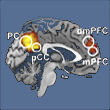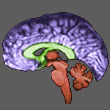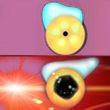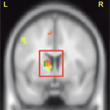Monday, 12 November 2012
Reasons Why We Curse

A few years back, the universality of swearing and curse words in all human languages attracted the attention of Harvard cognitive psychologist Steven Pinker. In his book The Stuff of Thought: Language as a Window into Human Nature, Pinker theorizes that the purpose of using swear words is to impose negative emotions on the people to whom we are talking, while stimulating primitive parts of their brain unbeknownst to them. Curse words appear to activate the brain’s right hemisphere more than the left, the basal ganglia (for generating them) and the amygdala (for perceiving them). (more…)
From Thought to Language | Comments Closed
Monday, 5 November 2012
Socio-Political Conflicts and Brain Imaging
 Until the start of the 21st century, brain-imaging techniques had been used chiefly to confirm the involvement of brain structures that had already been associated with well documented functions such as movement, vision, and language. But subsequently, as these non-invasive methods became more readily available, researchers began to use them to explore other, more complex functions. In this way, researchers have since discovered numerous neuronal circuits specifically associated with higher functions ranging from compassion to love, from meditation to intellectual pleasure.
Until the start of the 21st century, brain-imaging techniques had been used chiefly to confirm the involvement of brain structures that had already been associated with well documented functions such as movement, vision, and language. But subsequently, as these non-invasive methods became more readily available, researchers began to use them to explore other, more complex functions. In this way, researchers have since discovered numerous neuronal circuits specifically associated with higher functions ranging from compassion to love, from meditation to intellectual pleasure.
Recently, researchers have even demonstrated that Arabs’ and Israelis’ biases against each other were specifically correlated with activity in the precuneus (labelled PC in the image above), an area in the parietal cortex! The report on this brain-imaging experiment was published in 2010 by Emile Bruneau and Rebecca Saxe, of MIT, in Cambridge, Massachusetts. Dr. Saxe’s laboratory does research on Theory of Mind, in other words, the ability that people have to think about their thoughts, and in particular, to make hypotheses about other people’s thoughts, intentions, motivations, and beliefs. (more…)
The Emergence of Consciousness | Comments Closed
Monday, 29 October 2012
Dusting Off the Triune Brain and the Limbic System
 In neuroscience, as in other fields, some concepts are so convenient that it no longer even occurs to us to question them. But no scientific knowledge can be taken for granted forever, so it makes sense to take such old concepts down from the shelf and dust them off from time to time.
In neuroscience, as in other fields, some concepts are so convenient that it no longer even occurs to us to question them. But no scientific knowledge can be taken for granted forever, so it makes sense to take such old concepts down from the shelf and dust them off from time to time.
Recently, two neuroanatomists, Pierre-Yves Risold and Helmut Wicht, did just that with two models—the “triune brain” and the “limbic system”—that have become questionable, to say the least, in light of more recent neuroanatomical findings. (more…)
Emotions and the Brain, Evolution and the Brain | Comments Closed
Monday, 22 October 2012
Optogenetics: Neurons Controlled by Light

Among the many new techniques developed in the neurosciences in recent years, few have caused as much of a stir as optogenetics. This strange marriage between the sciences of optics and genetics allows the activity of entire populations of neurons in the brains of living animals to be controlled with a simple ray of light. Just a decade or two ago, such a technique, which is relatively non-invasive and accurate to within one millisecond, would have been unimaginable! (more…)
Emotions and the Brain, The Senses | Comments Closed
Wednesday, 17 October 2012
Learning How To Pique Curiosity

What is learning? What teaching methods are the most effective? Under what conditions do we remember information best? These are big questions, and the subject of continuing debate.
Neuroscientists continue to contribute relevant data to this debate, in particular as regards the conditions that help us learn and retain information best. In 2009, Min Jeong Kang’s research team published a brain imaging study that confirmed the importance of a well known but often under-utilized condition for enhancing learning: curiosity. (more…)
Memory and the Brain | 3 comments »







